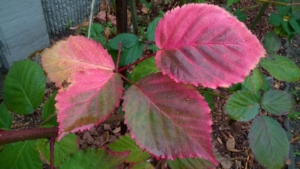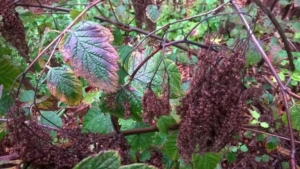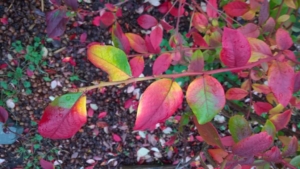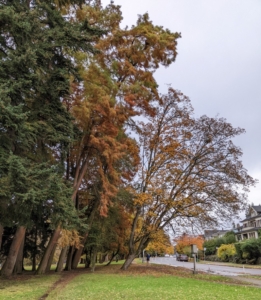The Essence of Senescence
November 6, 2024
To say “deciduous plant” implies seasonal leaf senescence (leaf shedding), a process that helps the plant optimize photosynthesis and nutrient efficiency. Senescence is a good survival strategy for plants in that the abundant nutrients within the leaves are not lost, they are transferred to shoots and roots, readying the plant to spring in the spring.
Many molecular activities of plant senescence are unknown, due to their complexity. Deciduous forests, as we know them, have been around 30 million years; that’s a lot of time to develop intricate survival strategies! The ever mysterious hormones are the drivers for the timing of leaf fall, but environmental cues, like cooler temperatures and reduced sunlight, are key factors for seasonal senescence.
As chlorophyll degrades in leaves, other pigments are revealed and cause the lovely autumn leaf color, one of the most obvious visible signs of senescence. This degradation protects the plant from environmental stresses during times when new growth would be dangerous.
But where did the green color of the leaves go? Well, where did the green come from in the first place? Chlorophyll is a green pigment found in the chloroplasts of plant leaves. Chlorophyll absorbs energy from violet-blue and orange-red wavelengths, but it poorly absorbs green portions of the light spectrum. The green wavelengths bounce off of the leaf and onto your eyeball!
for work parties
Please email to volunteer
freewayestatescommunityorchard@gmail
But there are other pigments in the leaf in addition to chlorophyll. Cartenoids can produce a brown color, then, after the chlorophyll is degraded, they produce yellow.
Now come the curtain raiser pigments! Red and purple colors come from a third class of pigments, anthocyanins, which develop in late summer. Trees with acidic sap will have red leaves (blueberries!) and those with alkaline sap will look purple-to-blue. The leaves need full sun to expose the most brilliant leaf colors.
The leaf changes color but why do they fall onto our sidewalks and streets where we have to rake them all up? This is leaf abscission, or leaf shedding. The abscission zone, at the base of the leaf near the stem, is formed well before fall. Then, just before senescence, two layers of cells form within the abscission zone – an outer thin weak separation layer and an inner protective layer where fatty acids are formed to block off nutrient and water movement (the leaf scar).
To a plant, senescence is a complex survival strategy. To you and me, senescence yields beautiful fall colors and a nice opportunity to exercise outdoors.
Ruth
Notes:
Sequential leaf senescence, versus seasonal leaf senescence, is normal during the growing season, whereby older basal leaves yellow while upper leaves remain productive. Leaf senescence can also occur when environmental conditions are nasty: drought, mineral deficiency, too much UV-B radiation, ozone, temperature extremes, too much light or too much darkness. Pests or pathogens can also cause leaves to drop prematurely.
Evergreen plants also shed leaves but not all at once like deciduous plants.
Note that our western larch (Larix occidentalis) is a deciduous conifer, one of the world’s few!
References:
Plant Physiology and Development, 6th Edition
p665-689 Leaf Senescence – The Regulatory Network
L Taiz et. al., 2015, Sinauer Assoiciates, Inc.
Senescence in Plants | Definition, Benefits & Hormones
K Reis, Nov 2023, Study.com
https://study.com/learn/lesson/senescence-plants-overview-process.html?srsltid=AfmBOopbKDGiAXOh0q5oeQNXVO4GTedDjhg5nBE6y35BdxBgsM6RZFv3
Plant senescence: how plants know when and how to die
H. R. Woo, Feb. 2018, J Exp Bot 12;69(4):715–718
https://pmc.ncbi.nlm.nih.gov/articles/PMC5853233/
Abscission: The Reason Why Leaves Fall
B. Thomas, Nov. 2007, Loyola University
https://lucec.loyno.edu/abscission-reason-why-leaves-fall
The Mystery of Autumn Colors
J. Cooper, Master Gardener, April 2014, WSU Extension
https://s3.wp.wsu.edu/uploads/sites/2054/2014/04/AutumnColors.doc
Fall foliage season: Time for “Larch Madness”
CBS Sunday Morning, Connor Knighton-narrator, Oct 24, 2024
video linkhttps://www.youtube.com/watch?v=ok1XPpLoL_c
Fall Leaf Color: Why No Blue Leaves?
Jay Hayek, no date, Ask extension, Univ. of Illinois
https://web.extension.illinois.edu/askextension/thisQuestion.cfm?ThreadID=13974&catID=192&AskSiteID=87ThreadID=13974&catID=192&AskSiteID=87
Sequential Leaf Senescence and Correlatively Controlled Increases in Xylem Flow Resistance
Peter M. Neumann, Plant Physiology, Vol. 83, No. 4 (Apr., 1987), pp. 941-944 (4 pages)
https://www.jstor.org/stable/4270541
A Fieldbook – Great Mountain Forests
M. Gaige, 2016, Yale Global Institute of Sustainable Forestry
link to pdfhttps://yff.yale.edu/sites/default/files/files/GMF%20Fieldbook%20-%20DEVELOPMENT%20OF%20THE%20EASTERN%20DECIDUOUS%20FOREST(1).pdf






Thanks for an informative and timely summary of out seasonal change. A pleasure to read and remember.
Lovely to know more about this for contemplating as i rake this fall. Thank you!